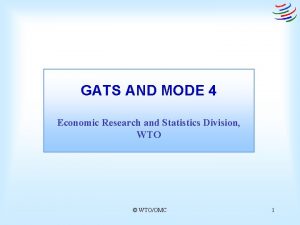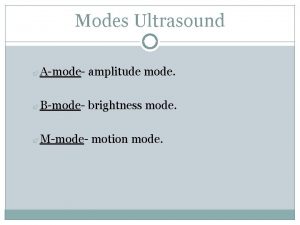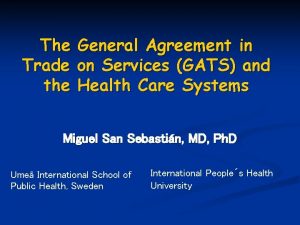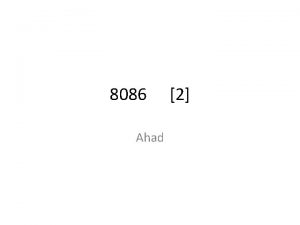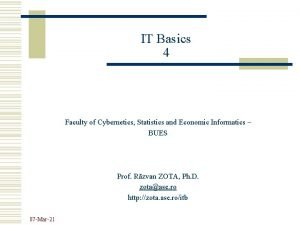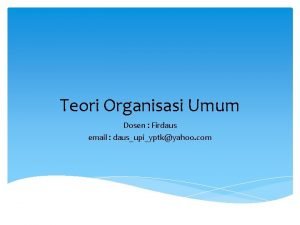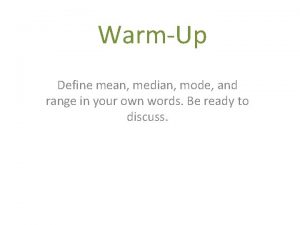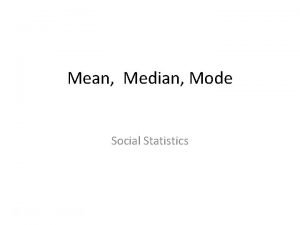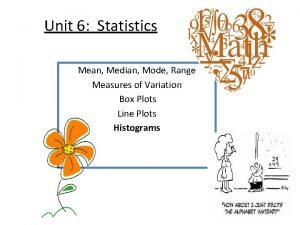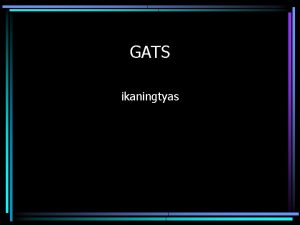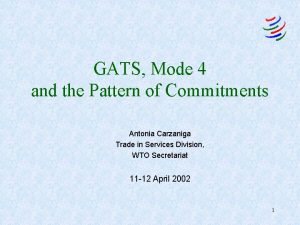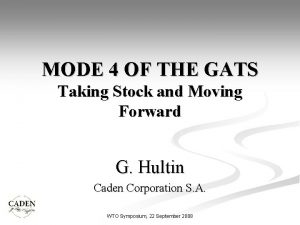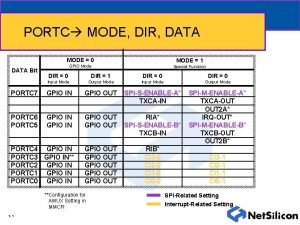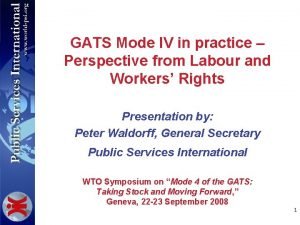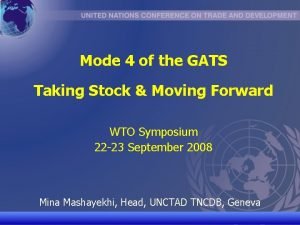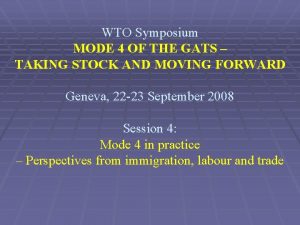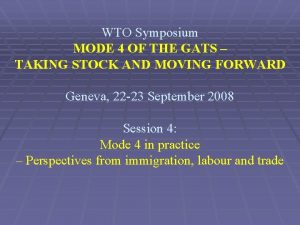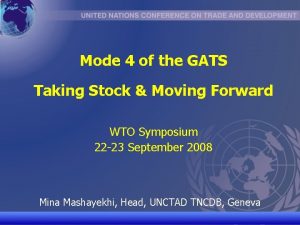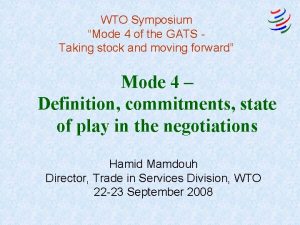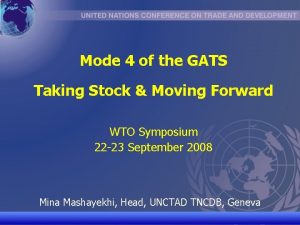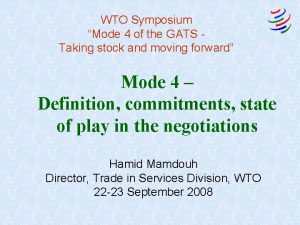GATS AND MODE 4 Economic Research and Statistics

















- Slides: 17

GATS AND MODE 4 Economic Research and Statistics Division, WTO © WTO/OMC 1

GATS and Mode 4 What is GATS ? The four modes of supply Relevant framework for mode 4 • GATS’ main text: mode 4 presence of natural persons • GATS’ Annex movement of natural persons Mode 4: Who is in and who is out ? Snapshot of current mode 4 commitments © WTO/OMC 2

GATS: Scope, Coverage, Definition n MEASURES AFFECTING TRADE IN SERVICES AT ALL GOVERNMENT LEVELS n ALL SERVICES (except air traffic rights and services supplied in the exercise of governmental authority) n FOUR MODES OF SUPPLY - Cross-border supply - Consumption abroad - Commercial presence - Presence of natural persons © WTO/OMC 3

GATS The GATS Pillars and Commitments Set of general obligations and disciplines GATS Pillars Countries schedules of specific commitments Annexes on specific issues Commitments under GATS By services sectors By mode of supply © WTO/OMC 4

GATS The Services Sectoral Classification List GNS/W/120 1. Business services 2. Communication services 3. Construction and related engineering services 4. Distribution services 5. Educational services 6. Environmental services 7. Financial services 8. Health-related and social services 9. Tourism and travel-related services 10. Recreational, cultural and sporting activities 11. Transport services 12. Other services not included elsewhere © WTO/OMC 5

The 4 Modes of Supply Under GATS (1/2) GATS COUNTRY A COUNTRY B Mode 1: service transactions Consumer from A The service crosses the border Supplier Mode 2: service transactions The consumer goes abroad Consumer from A Service supply Supplier Mode 3: service transactions Consumer from A Service supply Foreign affiliate Direct investment in country A © WTO/OMC Company 6

The 4 Modes of Supply Under GATS (2/2) GATS COUNTRY A COUNTRY B Mode 4: service transactions Consumer from A Service supply Natural person Self-employed goes to country A or employee sent by firm from B Natural person Mode 4: employment Foreign service firm Employment © WTO/OMC Natural person 7

GATS Relative Importance of Mode 4 Estimates at World level: – Mode 1 - ~ 35% – Mode 2 - ~ 10 - 15% – Mode 3 - ~ 50% – Mode 4 - ~ 1 - 2% Situation differs across services sectors and countries © WTO/OMC 8

MODE 4 The 4 th Mode of Supply Member A Member B Supply of a service by a service supplier of a Member through presence of natural persons of a Member in the territory of any other Member Service supplier Service consumer What does the supply of a service refer to? © WTO/OMC 9

MODE 4 Which natural persons? • Self-employed of Member A • Employed by a service supplier of Member A: – the employee is sent to Member B in respect of the supply of a service – Member A has commercial presence in Member B and sends its employee to its affiliate in Member B (intracorporate transferees) • Employed by a service supplier of Member B (host country) ? Does not exclude any level of skill © WTO/OMC 10

MODE 4 The Annex on Movement of Natural Persons • GATS does NOT apply to measures – affecting natural persons seeking access to the employment market – regarding citizenship, residence or employment on a permanent basis GATS does not define “temporary” © WTO/OMC 11

MODE 4 Services Goods Employees of domestic firms ? Employees Mode 4 Independent service suppliers Mode 4 All foreign workers abroad Mode 4 Non-permanent 12

MODE 4 The Annex on Movement of Natural Persons • Commitments can be scheduled by categories of natural persons • Governments are free to regulate entry and temporary stay, provided these measures do not nullify or impair the commitment footnote 1: differential visa requirements, not to be regarded as nullifying or impairing benefits under a specific commitment © WTO/OMC 13

MODE 4 Who is in and Who is out? Falling under Mode 4 Not falling under Mode 4 • Supply of services • Employees in the “goods” sector (Definition of particular services? ) • All skill levels • Intra-corporate transferees • Employees of host country Contractual service suppliers firms – Independent service suppliers – Employees of foreign service supplier Also: business visitors • Temporary movement • Permanent migration © WTO/OMC 14

MODE 4 Commitments A Snapshot of Mode 4 Commitments • Very few fully liberal commitments • Listing of measures: “Unbound except. . . ” • Governed by horizontal commitments • Mostly categories with high-level of training and expertise, often intra-corporate transferees • Specified duration of stay: 3 months to 5 years © WTO/OMC 15

MODE 4 Commitments Structure of Horizontal Commitments (108 Members, as of 2003) © WTO/OMC 16

MODE 4 Commitments Mode 4 and Current Commitments Mode 4 Commitments • Supply of services • Mainly horizontal commitments • All skill levels • Mostly high-level • Intra-corporate transferees (~70%) Contractual serv. suppliers (~10%) Business visitors (~20%) • Temporary movement • 3 -5 years: Intra-corporate transferees < 1 year: Contractual serv. suppliers < 3 months: Business visitors © WTO/OMC 17
 Gats mode 4
Gats mode 4 Brightness mode ultrasound
Brightness mode ultrasound Gats logo
Gats logo What is the problem
What is the problem Focus mode and diffuse mode
Focus mode and diffuse mode Difference between real mode and virtual mode of 80386
Difference between real mode and virtual mode of 80386 8086 vs 8088
8086 vs 8088 Asc code
Asc code Mode địa chỉ tức thì là mode
Mode địa chỉ tức thì là mode Timer modes of 8051
Timer modes of 8051 Gartner mode 1 mode 2
Gartner mode 1 mode 2 Perbedaan (planning mode) dan (evolutionary mode)
Perbedaan (planning mode) dan (evolutionary mode) Mean median mode range
Mean median mode range Mean median mode in statistics
Mean median mode in statistics Mode formula of grouped data
Mode formula of grouped data How to do mean median mode range
How to do mean median mode range Mode in statistics
Mode in statistics Economic growth and development
Economic growth and development
